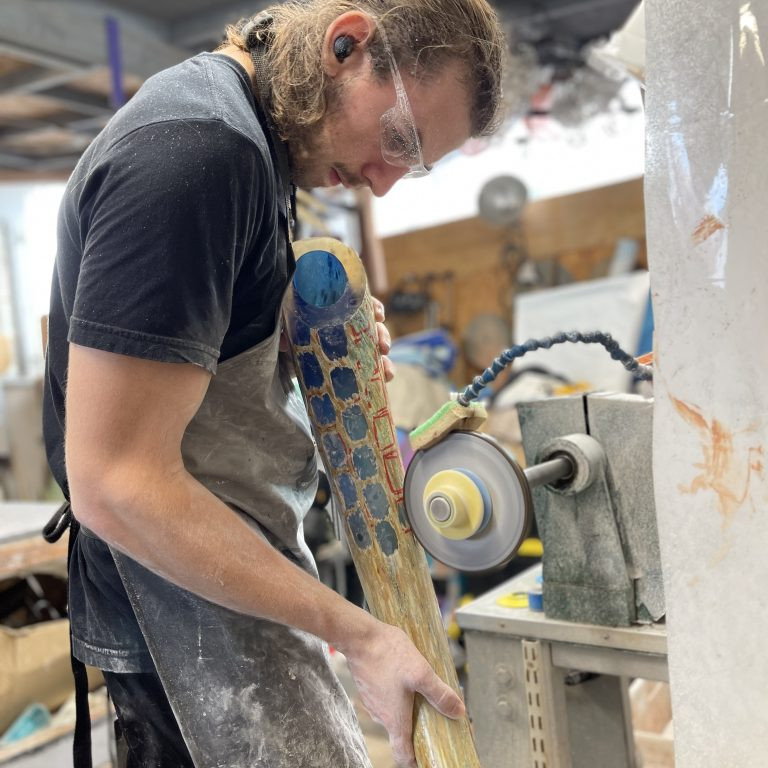Julie Payne Drawing / Installation Sculpture
You have been short listed for the Glover Prize on several occasions. Can you explain your work, and a little about the Glover Prize?
The Glover Prize is a prestigious landscape prize celebrating the Tasmanian landscape. I love being part of this exhibition as it always pushes the question of what constitutes “landscape”. My submissions are always specifically made for the “Glover” and often will examine emotive aspects of experienced memory and place. I grew up in the semi -remote north east of Tasmania and always look back at this time for visual stories to tell.
 Glover Prize Finalist Drawing “The Gorge in a Hundred Parts
Glover Prize Finalist Drawing “The Gorge in a Hundred Parts
Take ‘Spring Carnival’ and discuss the work and how you combined watercolour and pencil.
 “Spring Carnival” Pencil + Watercolour wash
“Spring Carnival” Pencil + Watercolour wash
I have always been interested in the play of known objects and combining additional elements to form another object. In this case it was the “fascinators” worn at spring carnival horse races and connecting the horseshoe as the basis of the headpiece and then attaching abundant native flora to form the fascinator.
Prior to this work I had been producing work only using graphite pencil but wanted to experiment with colour. With great tenacity I started to see how well watercolour and graphite can be combined. This then led to much greater confidence with colour in later work.
The importance of symbolism in this work.
I tend to use symbolism a lot in my work to initially capture the viewers gaze and once I have their attention, I want them to bring them on a journey of storytelling.
In Spring Carnival, the clue was the horseshoe and then it’s not such a leap to start thinking about horse racing, costume and place.
In the “Text Gardens” ie “The Garden of the Lost and Forgotten” superfine grass seed is used to establish the link with colonisation of the Australian landscape.
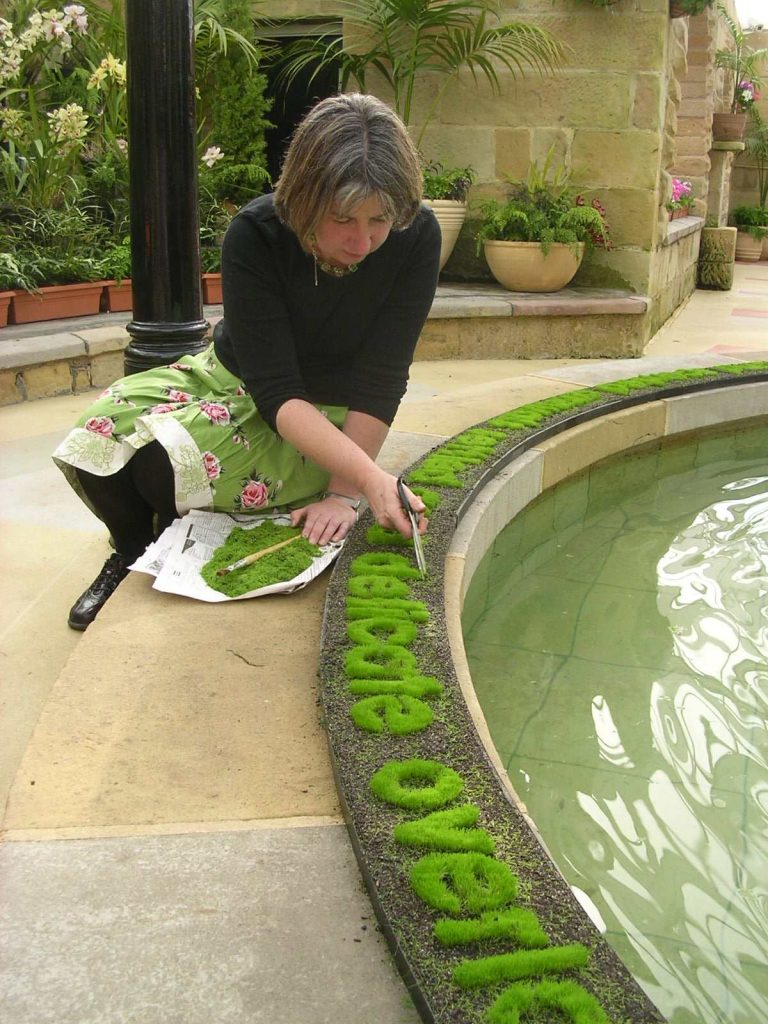 “The Garden of Human Happiness” grown grass text -detail of cutting. Tasmanian Royal Botanic Gardens.
“The Garden of Human Happiness” grown grass text -detail of cutting. Tasmanian Royal Botanic Gardens.
Comment on the importance of nature in your work.
During Art School I studied as a sculptor and loved the work of site-specific artists such as Richard Long, Rosalie Gascoigne, Andy Goldsworthy, Ken Unsworth, Anthony Prior, among many. All, at that period, were looking at a new approach to what sculpture could be and seemed to enjoy the direct response to a specific landscape.
Coming from a Sculpture department filled with noisy heavy machinery and time-consuming processes, the alure to making ephemeral art installations in the natural landscape was very attractive.
 “The Garden of Human Happiness” grown grass text – Tasmanian Royal Botanic Gardens.
“The Garden of Human Happiness” grown grass text – Tasmanian Royal Botanic Gardens.
How have you extended Botanical art to one with your own twist?
I started looking at botanical art as a return to drawing after studying and practicing architecture. Architecture requires exceptional care in details and botanical drawings worked on a similar level. However, I was not interested in the scientific principles of botanical work and instead used plants as symbols for storytelling. For instance, “Journey through the Contents of a Fridge” was a fun reminder of all the forgotten plants that congregate and form their own colony in unseen human made spots.
How does living in Tasmania influence your art?
After working in Brisbane, Melbourne and Darwin I realised the uniqueness of having a strong family connection to the north-eastern region of lutruwitta/Tasmania.
It was a raw and unprivileged childhood background that allowed immense scope for working out the way of the world on my own terms. It’s also incredibly beautiful place along with being a microcosm of political dissent, tragic colonial history and populated by extraordinary people that seemed to be sifted down to the bottom of Australia. There is plenty to be inspired by in the State.
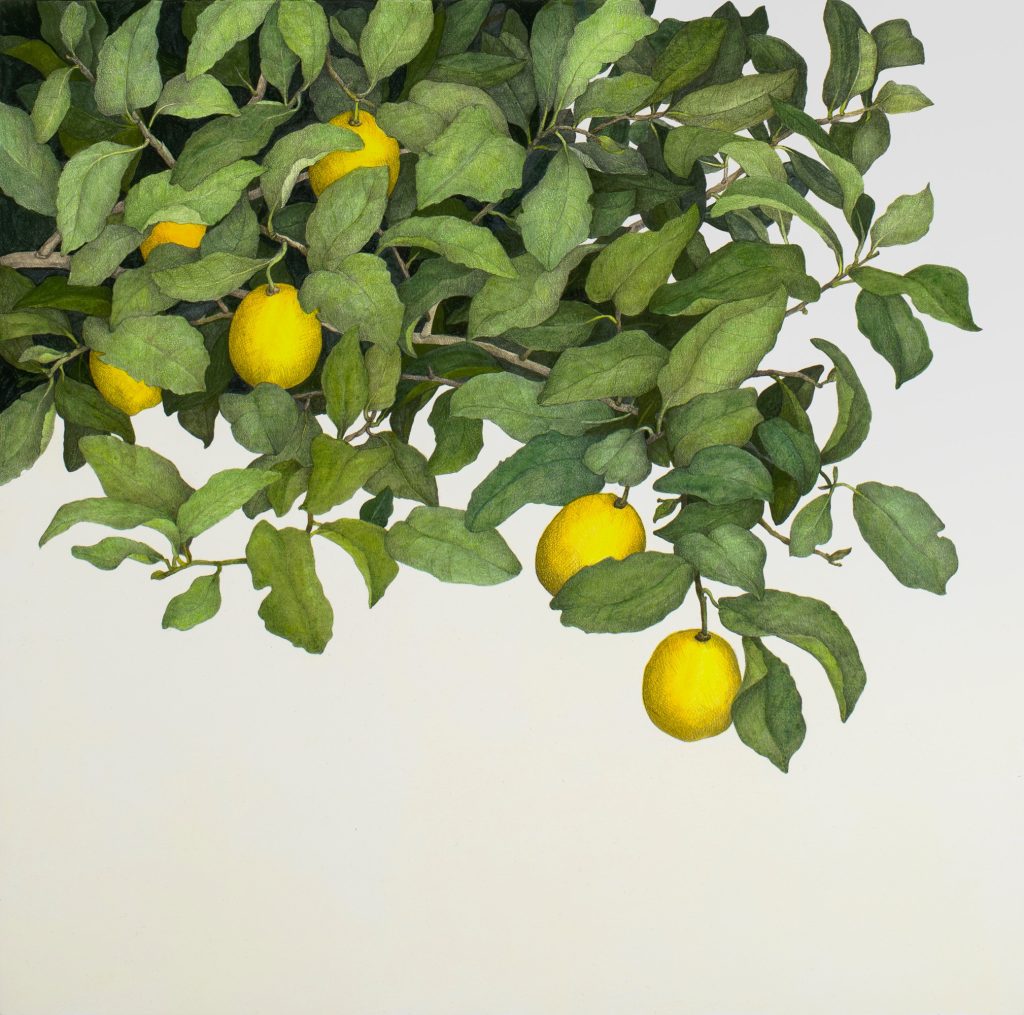 “Lemon Spritz” Watercolour + Pencil
“Lemon Spritz” Watercolour + Pencil
How does the art society in Tasmania nurture you and your art?
I don’t really have a connection to the Art Society apart from a few workshops to teach form techniques in drawing + colour washes.
Tell us about your studio?
I feel so incredibly lucky to have a studio at the Salamanca Arts Centre on the waterfront of Hobart.
Making art can be a very lonely occupation at times so greeting my studio buddies is a very positive way to start the day.
There are eight individual studios in our section of SAC, each occupied with dedicated professional artists. Although we mostly simply get on with our work after an initial greeting, we do have occasional celebratory gatherings to mark individual achievements. It’s a very positive working environment.
Of course, I could mention that the studio is spacious, light and located in fabulous Salamanca Place but it’s the heartfelt sharing that is number one.
Comment on your series, Flood Sticks, and your environmental presence in Tasmania.
Flood Sticks is a story based in memory and fragility while also showcasing the beauty of the Cataract Gorge in Launceston.
The “Flood Sticks” series focuses on the wildness of the Gorges that geographically divides the city. It is known for their spectacular and dangerous flooding events as well as its calm summer beauty. The sticks have been collected, stripped bare by the raging floods, and juxtaposed with the fragile boat vessels.
 “Flood Sticks” Scratchboard + collected flood sticks from Cataract Gorge.
“Flood Sticks” Scratchboard + collected flood sticks from Cataract Gorge.
You use many, different background papers in your work. Comment on this, particularly in relations to ‘IXL Still Life’.
 “IXL Still Life” Watercolour and Pencil over salvaged timesheets in concertina format.
“IXL Still Life” Watercolour and Pencil over salvaged timesheets in concertina format.
Experimenting with different papers is similar to a painter experimenting with different “grounds” on a canvas. Each produces a different effect and takes the initial preciousness away from starting a drawing.
In the IXL Still Life series, old timesheets from the Henry Jones IXL Jam Factory were collected, after the site was abandoned, and reused them in a linear format to imbue them with the fruit that was processed on site while also paying homage to the workers.
You have also extended this by putting your work in a book format, comment.
 “Journey through the Contents of a Fridge” pencil on paper.
“Journey through the Contents of a Fridge” pencil on paper.
The concertina book format was chosen to suggest a processing line and telling longer individual stories.
Discuss the use of humour in your work.
Along with tackling many political and emotive themes, I do enjoy a laugh as well.
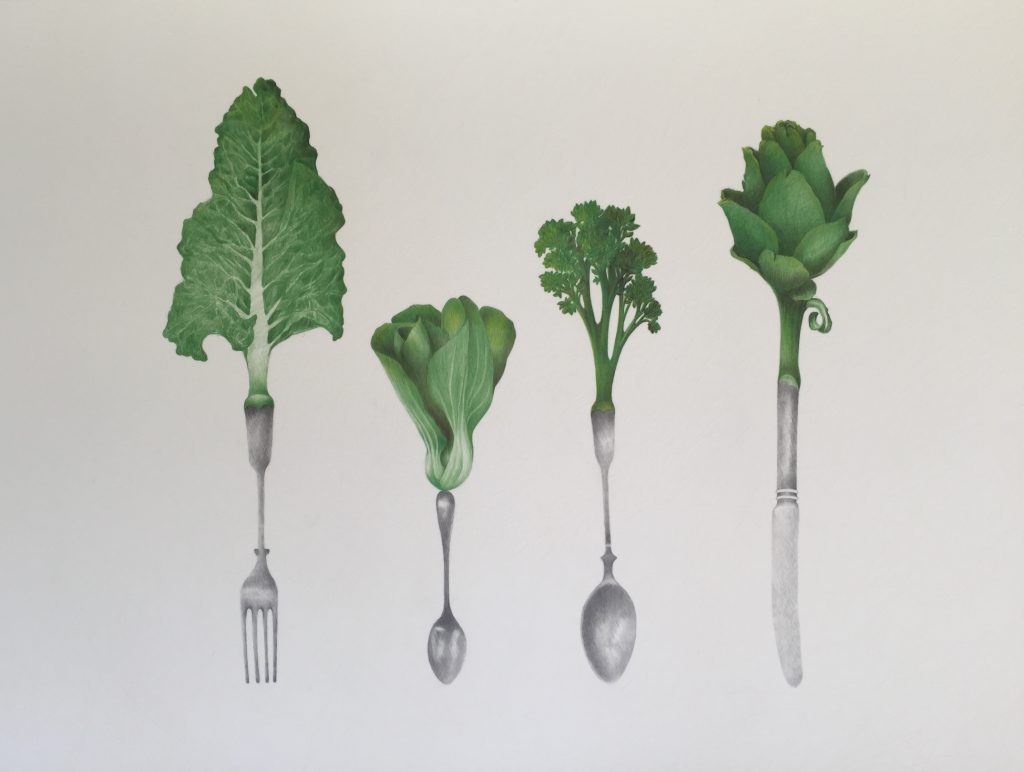 “The Culinary Greens” Graphite and coloured pencils.
“The Culinary Greens” Graphite and coloured pencils.
“The Culinary Greens” started as an exercise in using luscious, coloured pencils. It soon developed into a story of eating your greens and different families of vegetables. I saw the Culinary Greens as the apex family that everyone aspires to.
Beyond your studio, into gardens. How did this become such a large part of your art practice?
In 2001 I was commissioned to produce artwork to celebrate the opening of the Queen Victoria Museum, Inveresk site in Launceston. It was a disused railway yard employing hundreds of workers during its days. The Museum restoration had sanitised the huge site, eliminating the personal histories of tendered gardens and social gatherings that occurred. I liked to think that no matter how much new landscaping had been done, the tender history of site would always seep through and start telling stories. This is where the idea of growing text that suggested past activities originated. It was called “The Garden of the Lost and Forgotten” and I loved that you could not supress history so easily. It was also delightful tending this garden. It’s certainly high maintenance.
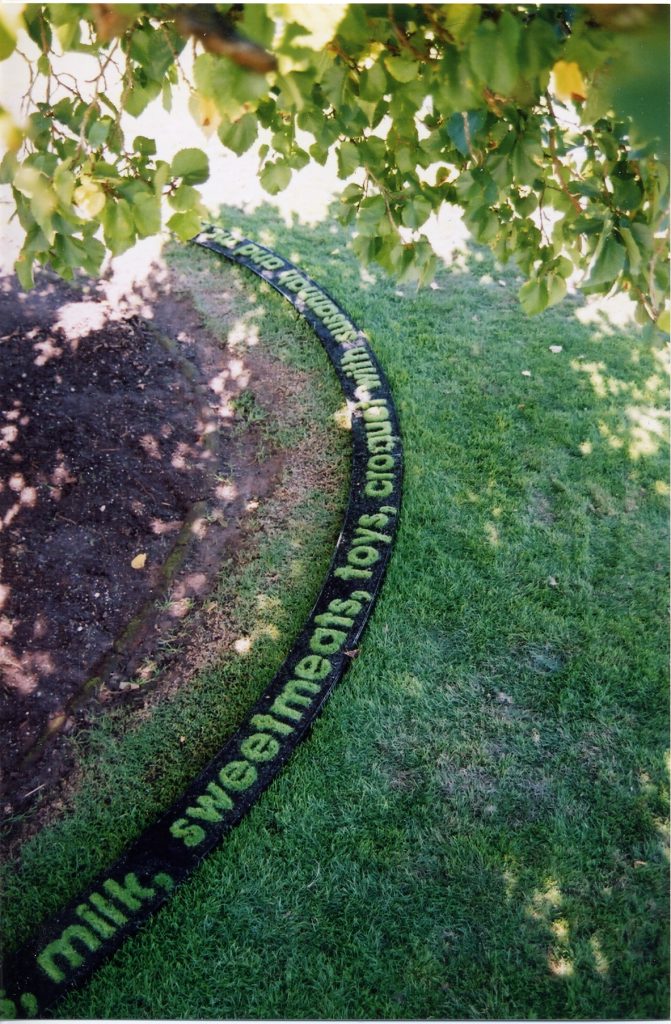 Garden of Loss and Desire” grown grass text – detail. Woolmers Estate
Garden of Loss and Desire” grown grass text – detail. Woolmers Estate
However, the process, the stories that could be told, and the clean visual impact was very satisfying and I went on to grow another four text gardens commissioned for various festivals.
Explain your commission within the Conservatory at the Royal Tasmanian Botanical Gardens?
“The Garden of Human Happiness” was grown specifically to tell a wandering story around the fountain within the Conservatory of the Royal Botanic Gardens.
 “The Garden of Human Happiness” grown grass text – Tasmanian Royal Botanic Gardens.
“The Garden of Human Happiness” grown grass text – Tasmanian Royal Botanic Gardens.
What other installations have you done?
Other site specific Installations have been created for Woolmers Estate, Festivale in Launceston, and Kelly’s Garden in Salamanca Place, Hobart.
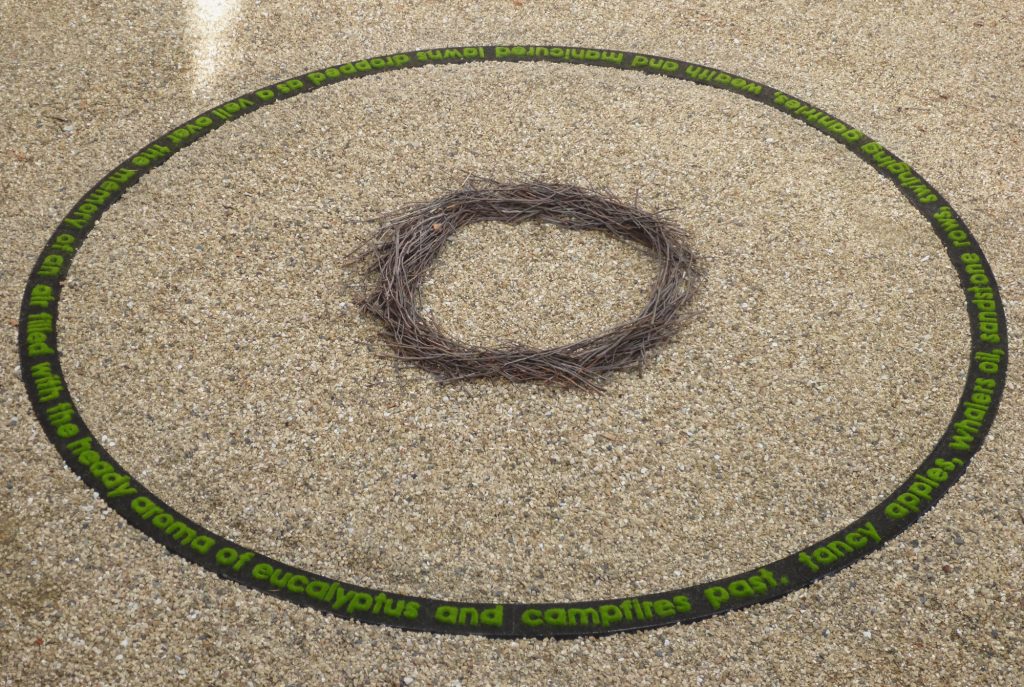 “Mr Peacocks Garden” grown grass text. Salamanca Arts Centre Hobart, Tasmania.
“Mr Peacocks Garden” grown grass text. Salamanca Arts Centre Hobart, Tasmania.
Ephemeral works locations have been located at the Cataract Gorge, Launceston; Fortescue Bay, Tasman Peninsula; Port Arthur Historic Site and Holly Bank Reserve.
How important is the weather for your installations?
A good downpour of rain is always welcome, although this often means a brisk growing session and lots of hand trimming with scissors. Gardens are always germinated in controlled greenhouse conditions until the words are stable enough for an outdoor location.
Does this art need both ‘Green Thumbs’ and tender loving care?
The art of Sculpture requires an artist to be a master of many crafts. One simply has to learn the craft and limitations of the material for each idea. Growing grass in the form of Helvetica Bold is no different.
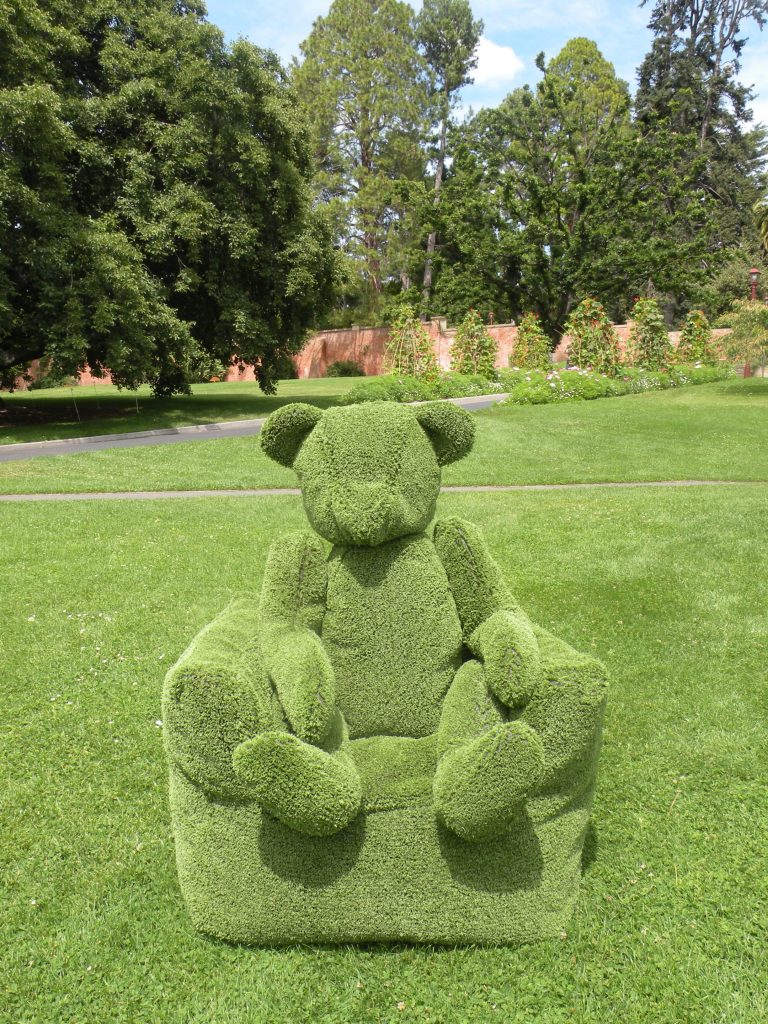
“Topiary Ted” sewn fake grass topiary
How did ‘Topiary Ted’ come to life?
“Topiary Ted” was a response to a group exhibition at the Royal Botanic Gardens in Tasmania. I thought it would be fun to upset the formalised gardens layout with some more unusual topiary. Obviously, I didn’t have the time to grow real topiary, so recycled tennis court Astro turf was sewn together to bring Ted into being.
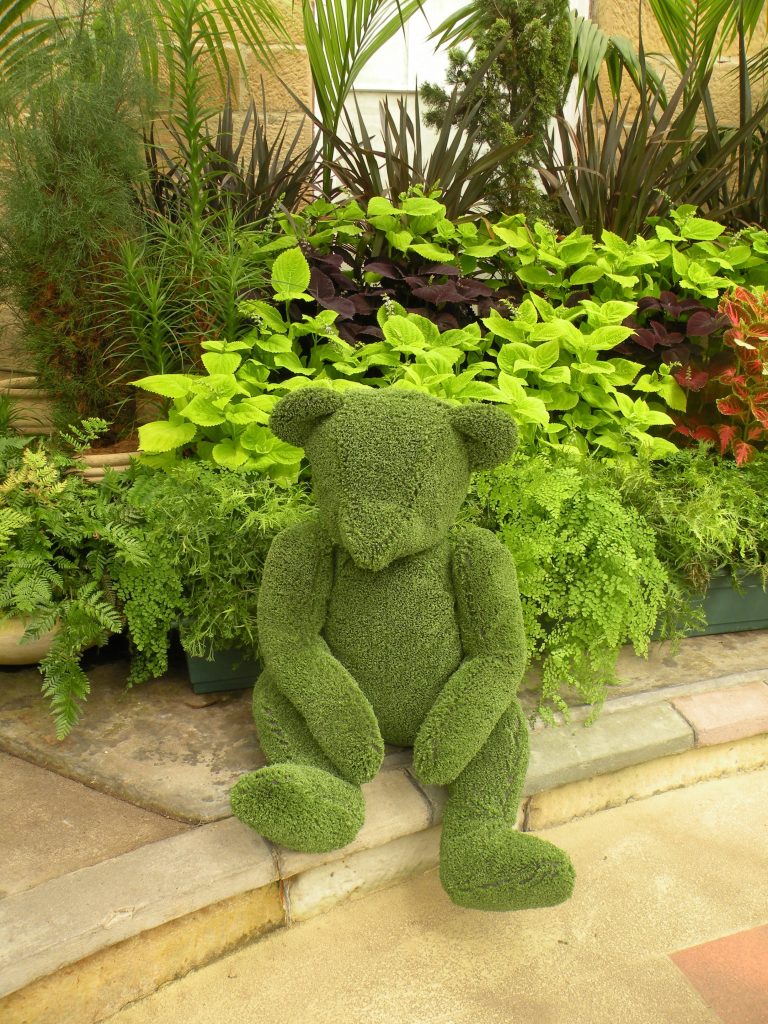
Ted was greatly loved, and I certainly learned the residual power of the childhood teddy bear on visitors.
Astro turf, fishing line and recycled plastic bags never seems to die, so three Teds now sit watchfully in my own garden.
Discuss Tasmanian history and your art?
There is plenty of Tasmanian history to examine and make comment on.
Tasmania has a history that is both culturally rich and, at times, devastatingly cruel and unequal.
Issues ranging from the in just treatment of the Palawa people and convict servitude to the privileged dominated the colonial times.
Relatively recent issues of deforestation, invasive species, environmental and social issues, and loss and memory have all been foundation ideas for various artworks.
Explain your involvement lecturing at the University of Tasmania.
Teaching at the University of Tasmania was a delight. After graduating in Architecture, I was asked to lecture three days a week in Foundation Studies with first year students.
In the second year of teaching at the School of Architecture, the School of Art invited me to teach Sculpture for the remaining two days available.
Although it was a bit crazy sometimes figuring out which school a student was in if I saw them out of context, I thoroughly enjoyed each and every student, yep, even the ratbag ones.
Teaching Sculpture at the School of Art taught me to quickly identify where a student was trying to head with an idea and hopefully assist with being able to distil the concepts’ essential qualities.
Teaching in the School of Architecture was a revision of the complex interplay of ideas, research, practicalities and building skills to think and draw three dimensionally.
You are busy doing residencies, take one that has led you to relook at your work.
I have been fortunate to be granted three studio residencies in France and Ireland. Each have had a positive impact in disrupting patterns of working but it was at Draw International in Caylus, France that was the most enjoyable. The quality of the participants is high, I thoroughly enjoyed discussing ideas, trying new less precious techniques and living in a small French community.
 Studio at Draw International – Caylus, France
Studio at Draw International – Caylus, France
Contact:
Julie Payne
Details
Julie Payne
Tasmania, Australia
Deborah Blakeley, Melbourne, Australia
Interview by Deborah Blakeley, April 2024
Images on this page are all rights reserved by Julie Payne
Think a colleague or friend could benefit from this interview?
Knowledge is one of the biggest assets in any business. So why not forward this on to your friends and colleagues so they too can start taking advantage of the insightful information the artist has given?
Other artists you may be interested in:





